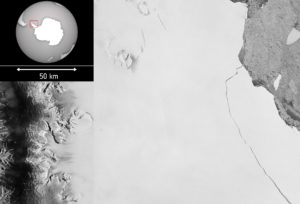Giant New Iceberg: Big Deal or Small Stuff?
“It’s a Boy.” The big news from Antarctica last Wednesday, was that Iceberg A68 was calved by the Larsen C ice shelf. The location on the Antarctic peninsula is shown on the map above with a yellow arrow.There has been a lot of confusion reported about this. Is it a big deal? Yes and no.
With a weight estimated at over a trillion tons, and dimensions almost one hundred miles by thirty (156 x 46 km) it is physically huge compared to usual icebergs. While I am glad that it has brought attention to this mysterious continent and the issues of warming oceans, melting ice and rising sea level, there has been a lot of hype and misunderstanding. I would suggest there are 3 key questions related to this event that everyone should understand.
#1 – Did this add to sea level? Simply “No.” Since A68 and all icebergs are floating ice, like giant ice cubes floating in a glass, melting does not affect the level of the liquid.The liquid in a glass can only get higher for three reasons: if you add liquid, add new ice, or if the liquid warms. Same with the ocean. Sea level mostly rises when ice from land breaks off and enters the sea, or as meltwater from glaciers on land finds its way to the sea. Also there is a very small increase in height as the liquid warms, what we refer to as “thermal expansion.”
#2 – Will this event lead to higher sea level? Probably yes, over the coming decades, but not directly from it melting. This giant iceberg broke off from an area known as the Larsen C ice shelf. Ice Shelves generally are large frozen areas inside a bay. (Bays are areas of sea partially surrounded by land, such as San Francisco Bay.) Ice shelves can be as much as a thousand feet in thick, but float on the sea. Thus, like icebergs, ice shelves have already had their effect on sea level.
The concern however is that ice shelves filling the bay and frozen solid, hold back the adjacent glaciers on land. The metaphor is that the ice shelves act like a stopper or cork in a bottle. There is a very strong case that as the ice shelves break up, the glaciers on land will then be able to slide into the sea. That new ice entering the ocean, definitely adds to rising sea level globally.
But even on this issue, the Larsen C Ice Shelf breaking off into Iceberg A68, will have modest effect. The Antarctic peninsula is relatively small. The area of the peninsula adjacent to Larsen C, is particularly narrow. The glaciers on land in that area are fairly small. Even if all of those glaciers fully slide into the sea, which could take many decades, the effect on global sea level will be minor.
#3 -Is this iceberg related to climate change or global warming? Scientists are divided on this question. Ice shelves do routinely break off into icebergs. Was the calving of Larsen C part of the natural process, or did it result from the warming ocean and changes to the currents around Antarctica?
I was at a conference on sea level for the entire past week at Columbia University in New York. With more than 350 scientists from around the world, opinions were mixed as to whether this ice fracture could be attributed to the warming temperature. It is difficult and even dangerous to infer or extrapolate from an event, when the event might have happened regardless. For a more thorough discussion of the warming trends and evidence, see https://johnenglander.net/uncertain-future-west-antarctic-ice-sheet-eos/ with a link to a professional journal article in EOS.
Regardless of A68 breaking off Larsen C ice shelf on the Antarctic Peninsula, our big concern is that the warming in Antarctica is now becoming evident in the main parts of the continent, West Antarctica and East Antarctica. In those two areas, much larger ice shelves are restraining (“buttressing”) massive glaciers, literally hundreds of times larger than the ones affected by the Larsen C ice shelf. News of dramatic melting, ponding water, and even rainfall in those areas are truly ominous. We must stay alert to any signs of melting in those areas.
Antarctica may be out of sight and out of mind for most. But what happens there and in Greenland in the months and years ahead, will have the most profound affect on coastal communities all over the world. We must not over-react to events like the calving on Larsen C, but we need to pay close attention. They may well be the “canary in the coal mine” that should alert us to something catastrophic.
As the ice sheets on Greenland and Antartica melt, combined with the two hundred thousand glaciers from Alaska to the Alps, global sea level will eventually rise tens of feet (meters) higher. We still have time to slow the warming and certainly have time to begin adapting to that which is now unavoidable.
Sea level has changed little in thousands of years, effectively all of human civilization. The last time sea level was higher was over a hundred thousand years ago, when it reached a high water mark about 25 feet (7-8 meters) above present. Now sea level is on the rise again and will transform coastal communities worldwide. The “ice ages” were a natural climate cycle, but now we are in a new era. We have a lot to learn. The patterns of CO2, global temperature, and sea level provide an easy-to-understand single graphic, that illustrates we have entered a new period.
One way to stay informed, to get the science in plain language, is to subscribe to Sea Level Rise Now, my weekly digest of news.


